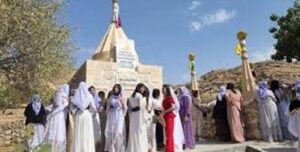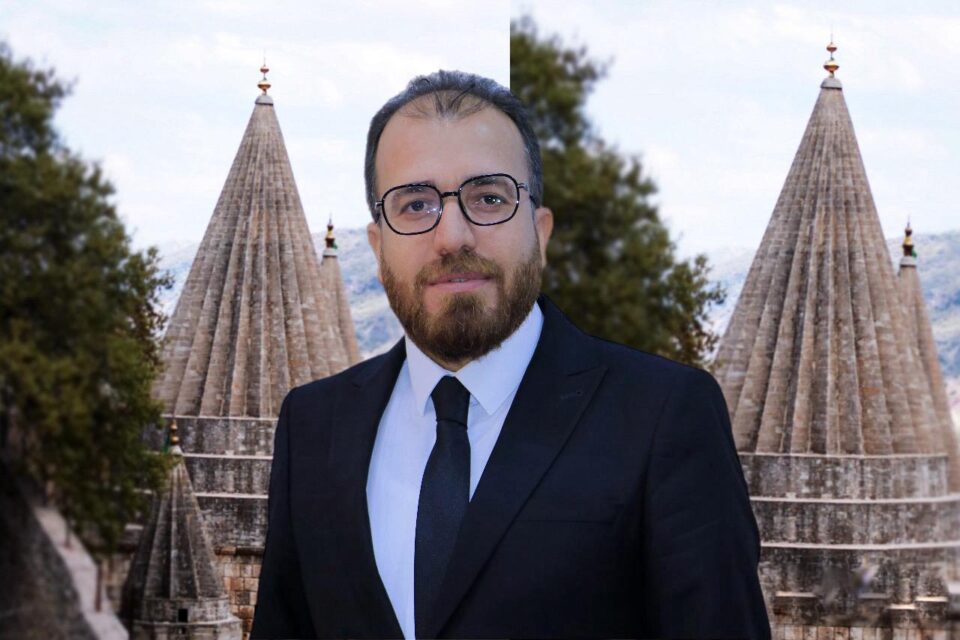 Ass. Prof. Dr. Faris Keti
Ass. Prof. Dr. Faris Keti
Yazidi Academic and Activist
The concept of fasting has ancient roots and is found across many old civilizations, often bind to religious, philosophical, cultural, or health-related practices. The Sumerians (~3100 BCE) practiced religious rituals that involved abstaining from certain foods as offerings to their gods. While acts of self-denial and purification (early precursors to fasting) are mentioned in their religious texts, evidence of formalized fasting is not extensively documented in the early Sumerian civilization (1). On the other hand, the Egyptians practiced forms of ritual fasting, often tied to religious observances. For example, priests abstained from food during periods of ritual preparation, particularly when entering temples or performing sacred rites (2).

Fasting in Greece was both religious and philosophical. The Greeks’ fasting was associated with purification and discipline. Pythagoras and his followers advocated fasting for mental clarity and physical health. Where initiates abstained from food as part of a purification process, the philosopher Socrates and others like Plato fasted to enhance their mental acuity and engage in spiritual practices (3). Although they were influenced by the Greeks, the Romans practiced fasting in a less formalized way but still saw it as a form of religious observance and discipline. They undertook fasting to honor the gods or seek clarity before important decisions or during certain festivals. Early christians in the Roman Empire introduced formalized fasting practices (e.g., Lent), which became a central part of christian tradition. On the other side, it’s important to note that Vedic traditions in ancient India (~1500 BCE) included fasting as part of religious and spiritual practices (e.g., the Upanishads mention fasting as a way to purify the body and connect with the divine) (4).
 Greek philosophers like Socrates and Plato engaging in discussions
Greek philosophers like Socrates and Plato engaging in discussions
Copyright: VisualCreative1, Credit: AI-generated image created by VisualCreative1
In Abrahamic religions (Judaism, Christianity, and Islam), fasting plays a crucial role and serves as a spiritual act of loyalty, purification, and discipline. Each faith includes fasting with its own distinct practices, rituals, and theological principles (5). Fasting has been a central component of Jewish religious life for thousands of years. It is often associated with repentance, atonement, and mourning. The key fasts in Judaism are: Yom Kippur (Day of Atonement), the most sacred fast, observed on the 10th day of Tishrei (a fall month in the Jewish calendar). It is a 24-hour fast during which Jews abstain from food, drinks, bathing, and other physical comforts seeking for forgiveness and restoring relationship with God. The other key fast is Tisha B’Av which commemorates the destruction of the First and Second Temples in Jerusalem and other tragic events in Jewish history. In addition, there are several minor fasts (shorter fasts), often lasting from sunrise to sunset, such as: Fast of Esther, Fast of Gedaliah (after Rosh Hashanah) 10th of Tevet (blockade of Jerusalem), and 17th of Tammuz (breach of Jerusalem’s walls) (6-7).
Fasting in Judaism has biblical roots as it has been mentioned in the Hebrew Bible (Tanakh) as a sign of repentance and humility before God (e.g., Moses fasted for 40 days on Mount Sinai, Jonah’s story of Nineveh’s repentance through fasting) (8).

In Christianity also, fasting has biblical roots as it has been mentioned throughout the Old and New Testaments (e.g., Jesus fasted for 40 days in the desert (Matthew 4:2), early christians practiced fasting as part of their devotion (Acts 13:2)) (9). Fasting in Christianity is a significant spiritual practice, although its observance varies among denominations. The key fasts in Christianity are: Lent (A 40-day period leading up to Easter (commemorating Jesus’ 40 days of fasting in the wilderness)), Good Friday (A day of fasting to commemorate the crucifixion of Jesus), Advent (in some traditions (e.g., Eastern Orthodoxy), a period of fasting and preparation before Christmas), and Voluntary Fasting (many christians fast privately as a spiritual discipline to strengthen their relationship with God).

In Islam, fasting is a fundamental pillar, known as Sawm. Fasting is a deeply spiritual practice that reflects obedience, gratitude, and self-control (5). The key fasts in Islam are: Ramadan (the most important fasting period, observed during the 9th month of the Islamic lunar calendar), Ashura (observed on the 10th day of Muharram), and Voluntary Fasts (e.g., the Day of Arafah-the day before Eid al-Adha). Fasting in Islam has Quranic and Hadith roots (e.g., Surah Al-Baqarah) (10).
The Yazidi religion is one of the ancient religions in Mesopotamia and the era. The meanings of fasting in it carry complex religious and philosophical connotations and carry dimensions similar to fasting in ancient civilizations before the Abrahamic religions, and also carry some of the meanings and concepts shared with the Abrahamic religions as well, as a result of the influence of the environment and the cultural overlap and exchange throughout history (11).
 Lalish Temple, Photo Credit: Sema TV
Lalish Temple, Photo Credit: Sema TV
Consequently, the Yazidi religion, one of the world’s oldest monotheistic traditions, has unique fasting practices that are deeply rooted in its spiritual beliefs and rituals. Fasting in the Yazidi religion, known as (Rojîyê Êzî), or (Rojîyê Çîlê) or (Rojîyê) in general which means (The Fast) is a significant act of worship and devotion. It is a way to honor God and to cultivate spiritual discipline and purification. The key fasts in Yezidism are: The Three-Day Fast (Rojîyê Êzî) is the most prominent fasting period which occurs in December, during the three days preceding the winter solstice. This fast is observed from dawn until sunset for three consecutive days. During this time, Yazidis abstain from food, drink, and smoking. The fast is broken each evening with a communal meal, which is often a time for prayer and reflection. This three-day fast is dedicated to God as a way of expressing gratitude and reinforcing the connection between Yazidis and their Creator. The other key fast in Yezidism is (Rojîyê Çîlê) which is a less commonly practiced fast that involves 40 days of fasting, primarily observed by religious leaders, especially during winter and summer. It is seen as a time of deeper spiritual reflection. Finaly, Yazidis may fast voluntarily to seek blessings, purification, or as a form of personal penance (e.g., many Yazidis observe fasting (every) Wednesday, which is considered a holy day in Yezidism.

The Yazidi religion blends elements of ancient Mesopotamian beliefs and other regional traditions. Fasting is seen as a universal practice across these ancient systems, symbolizing purification and devotion to the divine. In Yezidism, fasting has religious roots. Yazidi oral tradition emphasizes that fasting is a way to purify the soul and demonstrates submission to a divine will and strengthens their spiritual bond with God. In addition, the Yazidi religious texts, imply the importance of self-discipline and dedication to divine principles. Furthermore, they emphasis on spiritual practices like prayer, devotion, and rituals which reflects the framework in which fasting operates (12). Yezidism is primarily an oral tradition, and religious leaders such as the Qewals (performers of sacred hymns) and Sheikhs pass down the practices and significance of fasting. Through Qewls (hymns), Yazidis learn the spiritual reasons for fasting, which include: Strengthening faith in God, achieving spiritual purification, and honoring the cosmic cycles tied to divine creation (13). While the Yazidi religion predates the Abrahamic faiths and is distinct in its theology, its fasting practices share some conceptual similarities. Just like Judaism, Yezidism sees fasting as an act of atonement and humility before God. Similar to Christianity, fasting is a spiritual preparation for sacred times, such as the winter solstice; and like Islam, Yezidism emphasizes discipline, self-control, and gratitude during fasting.

On the other hand, it has cosmological Foundations too, Yazidis believe that fasting reflects the cycles of nature and the cosmos. The Three-Day Winter Solstice Fast (Rojîyê Êzî) aligns with the natural world’s rhythm, signifying renewal and harmony with creation. Dr. Mamo Othman points out that the origins of fasting (Rojîyê Êzî) among followers of the Yazidi religion go back to two main sources (14). Firstly, It is related to the stars, as three stars appear in the sky at the beginning of the summer square, which are (Pir, Trazo, and Qara), and these stars begin to disappear one after the other during the three days of fasting (a star disappears every day).Secondly, the twenty-third to the twenty-fifth of December were the shortest days of the year, meaning the birth of the sun, and they used to fall on Wednesday. So, the Yazidis fasted on Wednesday in celebration of the sun’s birthday, then they added a day before and a day after its birth (Wednesday), and thus they used to fast for three days. The twenty-fifth of December is considered the birthday of the god (Mithra), and the birthday of Jesus (Christ) was also taken from it, but the Yazidis preceded them because they were sun worshippers.
As for the researcher Khaled Aloka, he says, “It is a feast of joy, winter solstice and the sun rising from its confinement, because our holidays are linked to nature in general, and it is a separator between the fast of truth and sharia, as mentioned in a Yazidi religious story.” (15).

The Yazidis lived through different stages of religion as a means of understanding nature and what is beyond it, to religion according to the Abrahamic concept (monotheism and the absolute God) to the stage of renewal and Sufism in the twelfth centuries. Therefore, fasting in the Yazidis system cannot be said to be a purely religious practice or a purely philosophical one or related to matters of nature, stars, metaphysics, etc. Perhaps it represents all of these concepts as a result of the temporal arrangements and passing through the aforementioned stages.
References:
1- Kramer, S.N. (1963) “The Sumerians: Their History, Culture, and Character.” Chicago, IL: University of Chicago Press.
2- Parry, H., Graf, F. and Philip, F. (1998) “Magic in the ancient world,” Phoenix, 52(1/2), p. 177. Available at: https://doi.org/10.2307/1088265.
3- Burkert, W. et al. (1987) Greek religion —, Harvard University Press. Available at: https://www.hup.harvard.edu/books/9780674362819 (Accessed: December 18, 2024).
4- Beard, M., North, J. and Price, S. (1998) Religions of Rome: Volume 2, A sourcebook. Cambridge, England: Cambridge University Press.
5- Peters, F.E. (1982) “Children of Abraham: Judaism, Christianity, Islam”, Princeton University Press, Available at: https://books.google.iq/books?id=bsV6QgAACAAJ.
6- The Torah: References to fasting in the books of Leviticus (16:29-31) and Jonah (3:5-10).
7- The Talmud: Detailed discussions on Yom Kippur and other fasts (Tractates Yoma, Taanit).
8- The Bible: Moses fasting on Mount Sinai (Exodus 34:28) and fasting in times of repentance (Joel 2:12),
9- The Bible: Jesus’ 40-day fast (Matthew 4:1-2) and early Christian fasting in Acts (Acts 13:2, 14:23).
10- The Quran: Fasting mandated in Surah Al-Baqarah (2:183-185).
11- Bottéro, J. (2001) Religion in ancient Mesopotamia. Chicago, IL: University of Chicago Press.
12- Kreyenbroek, P. G. (1995). Yezidism — its background, observances, and textual tradition. E. Mellen Press.
13- Allison, C. (2015) The yezidi oral tradition in Iraqi Kurdistan. 1st ed. London, England: Routledge.
14- Mamo Othman, Yazidi Academic, personal interview, 18-12-2024.
15- Khalid Aloka, Fasting in Yezidism, Bahzani net, 15-12-2021, Available at: https://volmar.sinformations.cfd/help/?32161731835980&extra_param_1=ctk50gl3kl6c73dikkcg.

